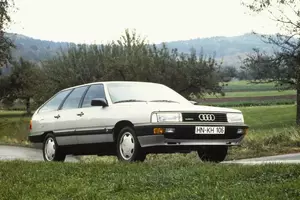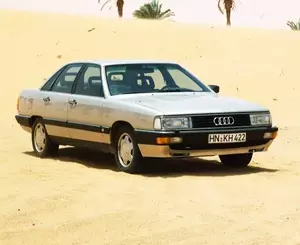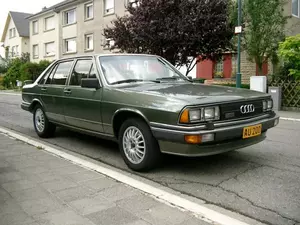
| Vehicle | Curb weight | Difference from world's smallest | Weight to power ratio | 0—60 mph acceleration ratio | Consumption ratio |
|---|---|---|---|---|---|
| 2.1 Turbo |
1450 kg / 3197 lbs |
1025 kg (2260 lbs) heavier | 8 kg to 1 hp | 186 kg/s (410 lbs/s) |
139 kg/L (306 lbs/L) |
| 2.2 20V Turbo |
1560 kg / 3440 lbs |
1135 kg (2503 lbs) heavier | 7 kg to 1 hp | 244 kg/s (538 lbs/s) |
144 kg/L (318 lbs/L) |
| 2.2 Turbo |
1450 kg / 3197 lbs |
1025 kg (2260 lbs) heavier | 9 kg to 1 hp | 186 kg/s (410 lbs/s) |
131 kg/L (289 lbs/L) |
| 2.2 20 V Turbo |
1560 kg / 3440 lbs |
1135 kg (2503 lbs) heavier | 7 kg to 1 hp | 244 kg/s (538 lbs/s) |
144 kg/L (318 lbs/L) |
| Vehicle | 2.1 Turbo |
|---|---|
| Curb weight |
1450 kg / 3197 lbs |
| Difference from world's smallest | 1025 kg (1025 lbs) heavier |
| Weight to power ratio | 8 kg to 1 hp |
| 0—60 mph acceleration ratio | 186 kg/s (410 lbs/s) |
| Consumption ratio |
139 kg/L (306 lbs/L) |
| Vehicle | 2.2 20V Turbo |
| Curb weight |
1560 kg / 3440 lbs |
| Difference from world's smallest | 1135 kg (1135 lbs) heavier |
| Weight to power ratio | 7 kg to 1 hp |
| 0—60 mph acceleration ratio | 244 kg/s (538 lbs/s) |
| Consumption ratio |
144 kg/L (318 lbs/L) |
| Vehicle | 2.2 Turbo |
| Curb weight |
1450 kg / 3197 lbs |
| Difference from world's smallest | 1025 kg (1025 lbs) heavier |
| Weight to power ratio | 9 kg to 1 hp |
| 0—60 mph acceleration ratio | 186 kg/s (410 lbs/s) |
| Consumption ratio |
131 kg/L (289 lbs/L) |
| Vehicle | 2.2 20 V Turbo |
| Curb weight |
1560 kg / 3440 lbs |
| Difference from world's smallest | 1135 kg (1135 lbs) heavier |
| Weight to power ratio | 7 kg to 1 hp |
| 0—60 mph acceleration ratio | 244 kg/s (538 lbs/s) |
| Consumption ratio |
144 kg/L (318 lbs/L) |

| Vehicle | Curb weight | Difference from world's smallest | Weight to power ratio | 0—60 mph acceleration ratio | Consumption ratio |
|---|---|---|---|---|---|
| 2.1 Turbo |
1410 kg / 3109 lbs |
985 kg (2172 lbs) heavier | 8 kg to 1 hp | 183 kg/s (404 lbs/s) |
140 kg/L (309 lbs/L) |
| 2.1 5E |
1260 kg / 2778 lbs |
835 kg (1841 lbs) heavier | 9 kg to 1 hp | 120 kg/s (265 lbs/s) |
133 kg/L (293 lbs/L) |
| 2.2 Turbo |
1290 kg / 2844 lbs |
865 kg (1907 lbs) heavier | 6 kg to 1 hp | 182 kg/s (401 lbs/s) |
123 kg/L (271 lbs/L) |
| 2.2 |
1290 kg / 2844 lbs |
865 kg (1907 lbs) heavier | 9 kg to 1 hp | - | - |
| 2.2 20V |
1520 kg / 3352 lbs |
1095 kg (2415 lbs) heavier | 7 kg to 1 hp | 241 kg/s (531 lbs/s) |
145 kg/L (320 lbs/L) |
| 2.4 |
1290 kg / 2844 lbs |
865 kg (1907 lbs) heavier | 9 kg to 1 hp | - | - |
| Vehicle | 2.1 Turbo |
|---|---|
| Curb weight |
1410 kg / 3109 lbs |
| Difference from world's smallest | 985 kg (985 lbs) heavier |
| Weight to power ratio | 8 kg to 1 hp |
| 0—60 mph acceleration ratio | 183 kg/s (404 lbs/s) |
| Consumption ratio |
140 kg/L (309 lbs/L) |
| Vehicle | 2.1 5E |
| Curb weight |
1260 kg / 2778 lbs |
| Difference from world's smallest | 835 kg (835 lbs) heavier |
| Weight to power ratio | 9 kg to 1 hp |
| 0—60 mph acceleration ratio | 120 kg/s (265 lbs/s) |
| Consumption ratio |
133 kg/L (293 lbs/L) |
| Vehicle | 2.2 Turbo |
| Curb weight |
1290 kg / 2844 lbs |
| Difference from world's smallest | 865 kg (865 lbs) heavier |
| Weight to power ratio | 6 kg to 1 hp |
| 0—60 mph acceleration ratio | 182 kg/s (401 lbs/s) |
| Consumption ratio |
123 kg/L (271 lbs/L) |
| Vehicle | 2.2 |
| Curb weight |
1290 kg / 2844 lbs |
| Difference from world's smallest | 865 kg (865 lbs) heavier |
| Weight to power ratio | 9 kg to 1 hp |
| 0—60 mph acceleration ratio | - |
| Consumption ratio | - |
| Vehicle | 2.2 20V |
| Curb weight |
1520 kg / 3352 lbs |
| Difference from world's smallest | 1095 kg (1095 lbs) heavier |
| Weight to power ratio | 7 kg to 1 hp |
| 0—60 mph acceleration ratio | 241 kg/s (531 lbs/s) |
| Consumption ratio |
145 kg/L (320 lbs/L) |
| Vehicle | 2.4 |
| Curb weight |
1290 kg / 2844 lbs |
| Difference from world's smallest | 865 kg (865 lbs) heavier |
| Weight to power ratio | 9 kg to 1 hp |
| 0—60 mph acceleration ratio | - |
| Consumption ratio | - |

| Vehicle | Curb weight | Difference from world's smallest | Weight to power ratio | 0—60 mph acceleration ratio | Consumption ratio |
|---|---|---|---|---|---|
| 2.1 5E |
1260 kg / 2778 lbs |
835 kg (1841 lbs) heavier | 9 kg to 1 hp | 122 kg/s (269 lbs/s) |
121 kg/L (267 lbs/L) |
| 2.1 5T |
1325 kg / 2922 lbs |
900 kg (1985 lbs) heavier | 8 kg to 1 hp | 160 kg/s (353 lbs/s) |
117 kg/L (258 lbs/L) |
| Vehicle | 2.1 5E |
|---|---|
| Curb weight |
1260 kg / 2778 lbs |
| Difference from world's smallest | 835 kg (835 lbs) heavier |
| Weight to power ratio | 9 kg to 1 hp |
| 0—60 mph acceleration ratio | 122 kg/s (269 lbs/s) |
| Consumption ratio |
121 kg/L (267 lbs/L) |
| Vehicle | 2.1 5T |
| Curb weight |
1325 kg / 2922 lbs |
| Difference from world's smallest | 900 kg (900 lbs) heavier |
| Weight to power ratio | 8 kg to 1 hp |
| 0—60 mph acceleration ratio | 160 kg/s (353 lbs/s) |
| Consumption ratio |
117 kg/L (258 lbs/L) |